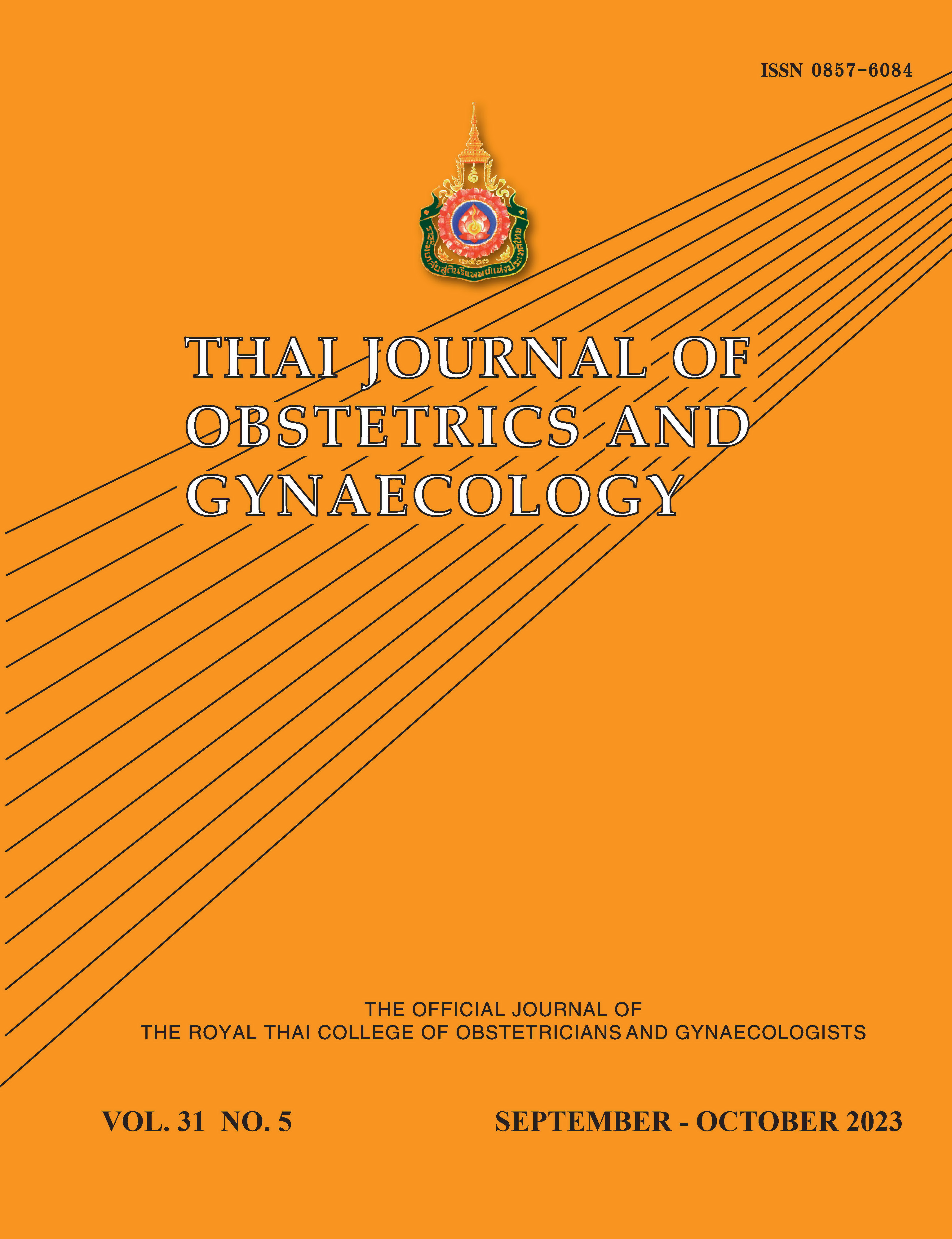Prevalence of and Factors Associated with Large Cesarean Scar Defects in Women at Six Weeks Postpartum
Main Article Content
Abstract
Objectives: To demonstrate the prevalence and factors associated with a large Cesarean scar defect (CSD) in Thai postpartum women.
Materials and Methods: This was a cross-sectional study. The participants were enrolled for a postpartum sonographic examination at the sixth-week follow-up from August to December 2021. CSD was measured using a two-dimensional transvaginal ultrasound device. A large CSD was defined as having a height of ≥ 50% of the total myometrial thickness. The sonographer was blinded to the obstetric history until all parameters had been recorded.
Results: At six weeks postpartum, CSD was identified in 94 participants. There were 64 and 30 participants in the primary and repeat Cesarean section (CS) groups, respectively. The overall prevalence of large CSD was 22.3%. A large CSD was seen in 15.6% (10/64) and 36.7% (11/30) of the patients in the primary and repeated CS groups. The factors associated with large CSD were repeated CS (p = 0.002), cervical dilatation ≥ 6 cm at the time of CS (p = 0.023), and uterine retroflexion (p = 0.015) groups, with odds ratio of 8.85 (95% confidence interval (CI) 2.29-34.15), 5.84 (95%CI 1.28-26.71) and 4.40 (95%CI 1.33-14.55), respectively.
Conclusion: The overall prevalence of large CSDs was 22.3%. Repeated CS, uterine retroflexion, and cervical dilatation ≥ 6 cm at the time of CS had higher odds of developing a large CSD.
Article Details

This work is licensed under a Creative Commons Attribution-NonCommercial-NoDerivatives 4.0 International License.
References
Betrán AP, Ye J, Moller AB, Zhang J, Gülmezoglu AM, Torloni MR. The increasing trend in caesarean section rates: global, regional and national estimates: 1990-2014. PLoS One 2016;11:e0148343.
van der Voet LF, Bij de Vaate AM, Veersema S, Brölmann HA, Huirne JA. Long-term complications of caesarean section. The niche in the scar: a prospective cohort study on niche prevalence and its relation to abnormal uterine bleeding. BJOG 2014;121:236-44.
Bij de Vaate AJ, Brölmann HA, van der Voet LF, van der Slikke JW, Veersema S, Huirne JA. Ultrasound evaluation of the Cesarean scar: relation between a niche and postmenstrual spotting. Ultrasound Obstet Gynecol 2011;37:93-9.
Kulshrestha V, Agarwal N, Kachhawa G. Post-caesarean niche (isthmocele) in uterine scar: an update. J Obstet Gynaecol India 2020;70:440-6.
Vikhareva Osser O, Valentin L. Clinical importance of appearance of cesarean hysterotomy scar at transvaginal ultrasonography in nonpregnant women. Obstet Gynecol 2011;117:525-32.
Nitayaphan N, Kitporntheranunt M. Cesarean scar defect and its complications. J Med Assoc Thai 2021;104:91-6.
Timor-Tritsch IE, Monteagudo A, Calì G, D’Antonio F, Kaelin Agten A. Cesarean scar pregnancy: diagnosis and pathogenesis. Obstet Gynecol Clin North Am 2019;46:797-811.
Jordans IPM, Verberkt C, De Leeuw RA, Bilardo CM, Van Den Bosch T, Bourne T, et al. Definition and sonographic reporting system for Cesarean scar pregnancy in early gestation: modified Delphi method. Ultrasound Obstet Gynecol 2022;59:437-49.
Hanacek J, Vojtech J, Urbankova I, Krcmar M, Křepelka P, Feyereisl J, et al. Ultrasound cesarean scar assessment one year postpartum in relation to one- or two-layer uterine suture closure. Acta Obstet Gynecol Scand 2020;99:69-78.
Buhimschi CS, Zhao G, Sora N, Madri JA, Buhimschi IA. Myometrial wound healing post-Cesarean delivery in the MRL/MpJ mouse model of uterine scarring. Am J Pathol 2010;177:197-207.
Esendagli G, Yoyen-Ermis D, Guseinov E, Aras C, Aydin C, Uner A, et al. Impact of repeated abdominal surgery on wound healing and myeloid cell dynamics. J Surg Res 2018;223:188-97.
Osser OV, Jokubkiene L, Valentin L. High prevalence of defects in Cesarean section scars at transvaginal ultrasound examination. Ultrasound Obstet Gynecol 2009;34:90-7.
Ofili-Yebovi D, Ben-Nagi J, Sawyer E, Yazbek J, Lee C, Gonzalez J, et al. Deficient lower-segment Cesarean section scars: prevalence and risk factors. Ultrasound Obstet Gynecol 2008;31:72-7.
Cunningham FG, Leveno KJ, Dashe JS, Hoffman BL, Spong CY, Casey BM, editors. In: Williams Obstetrics, 26th ed. New York: McGraw Hill; 2022.
Regnard C, Nosbusch M, Fellemans C, Benali N, van Rysselberghe M, Barlow P, et al. Cesarean section scar evaluation by saline contrast sonohysterography. Ultrasound Obstet Gynecol 2004;23:289-92.
Vervoort AJ, Uittenbogaard LB, Hehenkamp WJ, Brölmann HA, Mol BW, Huirne JA. Why do niches develop in Caesarean uterine scars? Hypotheses on the aetiology of niche development. Hum Reprod 2015;30:2695-702.
Diegelmann RF, Evans MC. Wound healing: an overview of acute, fibrotic and delayed healing. Front Biosci 2004;9:283-9.
Siraj SHM, Lional KM, Tan KH, Wright A. Repair of the myometrial scar defect at repeat caesarean section: a modified surgical technique. BMC Pregnancy Childbirth 2021;21:559.
Dicle O, Küçükler C, Pirnar T, Erata Y, Posaci C. Magnetic resonance imaging evaluation of incision healing after cesarean sections. Eur Radiol 1997;7: 31-4.
Vikhareva Osser O, Valentin L. Risk factors for incomplete healing of the uterine incision after caesarean section. BJOG 2010;117:1119-26.
Dosedla E, Calda P. Can the final sonographic assessment of the cesarean section scar be predicted 6 weeks after the operation? Taiwan J Obstet Gynecol 2016;55:718-20.
Jordans IPM, de Leeuw RA, Stegwee SI, Amso NN, Barri-Soldevila PN, van den Bosch T, et al. Sonographic examination of uterine niche in non-pregnant women: a modified Delphi procedure. Ultrasound Obstet Gynecol 2019;53:107-15.
Alalfy M, Osman OM, Salama S, Lasheen Y, Soliman M, Fikry M, et al. Evaluation of the Cesarean scar niche in women with secondary infertility undergoing ICSI using 2D sonohysterography versus 3D sonohysterography and setting a standard criteria; Alalfy Simple Rules for scar assessment by ultrasound to prevent health problems for women. Int J Womens Health 2020;12:965-74.
Marjolein Bij de Vaate AJ, Linskens IH, van der Voet LF, Twisk JW, Brölmann HA, Huirne JA. Reproducibility of three-dimensional ultrasound for the measurement of a niche in a caesarean scar and assessment of its shape. Eur J Obstet Gynecol Reprod Biol 2015;188: 39-44.


